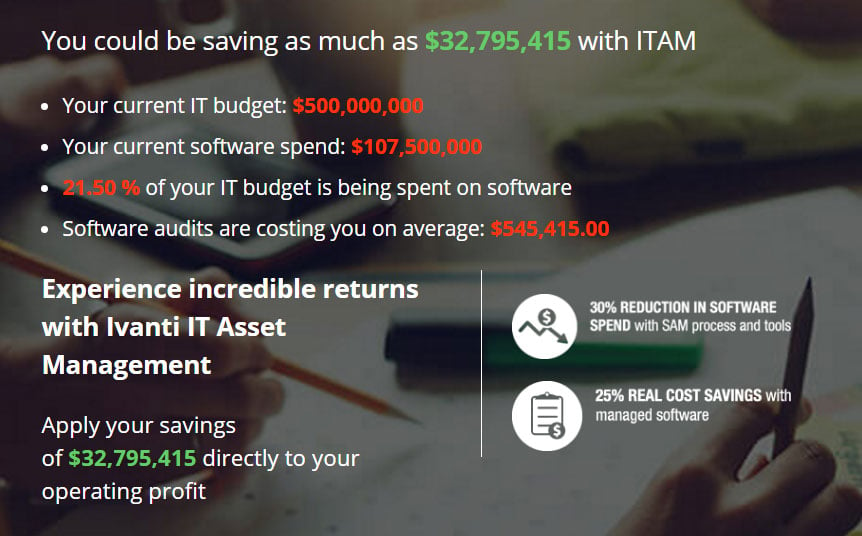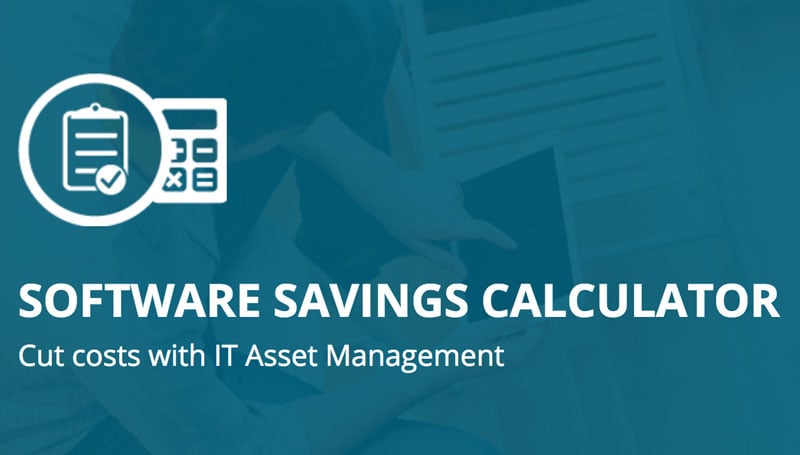Paying Too Much for Enterprise Software? Use Our IT Asset Management Calculator!
Whether it’s fear of software audits, license complexity, or lack of accurate tracking – chances are you’re spending way too much for the enterprise software for your organization without IT asset management practices.
Software makes up a large chunk of an organization’s annual IT Budget. Forrester estimates that 21.5 percent of an organization’s overall budget is swallowed up by software spendi. With the constant imperative to reduce costs, IT asset managers should not overlook opportunities to optimize their software spend.
So how big is the savings potential? Well, according to IAITAM - an effective IT asset management program can cut software costs by as much as 25% - 50%. Yes, some organizations are cutting spend in half thanks to IT asset management processes. ITAM also provides visibility into how many software titles they have, whether they’re licensed correctly, and whether they’re spending on licenses they’re not even using.
According to Gartner research, organizations that improve their Software Asset Management license optimization capabilities typically report up to 30%ii software spending reductions within one year. Gartner research indicates that 90%ii of organizations could benefit from software license optimizations. These savings are just too large to ignore.
Determining how much you can save on software isn’t always easy. That’s where the Ivanti ITAM Savings Calculator can help.
Answer three quick questions to see your software savings potential:
- What’s your annual IT budget?
- What’s your annual software spend?
- How many audits have you experienced in the last year?
With those three pieces of information, our ITAM Savings Calculator can give you an overview of your potential savings. Please note these are saving estimates. Your actual savings will vary depending on your size of organization, license types, devices running the software, IT and audit resources, etc.
A sample savings estimate
Let’s see the math in action. For the purpose of this blog, we’ll crunch the numbers for a sample organization with the following statistics:
- An annual IT budget of $500 million per year
- A 21.5% spend on software, so about $107.5 million per year
- They’ve experienced two audits in the last year
Most organizations realize that they could incur risks and fines by failing to manage their software assets efficiently, however, many do not understand that they are missing out on significant cost savings. Studies have shown that properly managing software can lead to as much as 30% savings by driving out hidden inefficiencies from over-licensing applications or harvesting and reclaiming unused software.
These are real cost savings. The combination of mitigating significant risk and realizing substantial savings provides organizations with a major opportunity to positively affect their business operations and bottom line. So again, here’s the calculation:
Software Optimization savings = 30% SAM savings x software spend
Based on the above, our sample organization could potentially save $32.25 million when they optimize their software usage with IT Asset Management tools.
Audit Costs
On average, 68% of organizations can expect at least one software audit request in the next 12 months. Adding to that, 52% of organizations say their software has been audited multiple times.iii
To combat the possible financial and reputational damage, 76% of organizations over-license and purchase more software than they use simply to avoid a software audit. Research reveals organizations usually over-license by as much as 30%, leading to what the industry calls ‘shelfware’.
This approach to over-licensing can result in significant overspend and still may not have the desired effect of reducing audits. As more software publishers move their customers to SaaS or cloud licensing models, audit activity has increased. Additionally, anytime there is a merger and acquisition, this increases audit risk because vendors recognize the business disruption creates an audit opportunity.
When factoring in the amount of time it takes to respond to an audit, which ITAM Review estimates is 7.13 months, the value proposition of an IT Asset Management program can usually be achieved within the first year.
Analyst Enterprise Management Associates (EMA) states that the average organization spends 30 hours reconciling asset inventory data and an additional 30 hours collecting asset entitlement data for a major audit. This becomes a huge distraction and waste of time for teams that have to drop projects to respond quickly to audits. Based on this research, we’ve calculated the following:
Cost of audit = [number of audits] x ([average hourly wage of IT Tech x average hours it takes to prepare for an audit] + [average true-up cost for license compliance])
The above works based on the following assumptions:
- An average audit consumes 194.15 hours of IT department time
- The average hourly wage of FTE (IT Tech) is $50/hour
- The average audit true-up cost for companies with $50 million in annual revenue is $263K; for companies with about $4 billion in revenue, it’s about $1.6 million
When we plug in those figures, you get:
Cost of Audit = 2 x (($50 x 194.15 hours) + $263,000) = $545,415
We believe this estimate to be on the low end of what the average audit might actually cost. This figure assumes that just one technician is involved in the preparation of the audit. Typically, an audit will involve multiple resources from technicians, operations, all the way through to legal and finance. Also, many vendors will insist on deploying their own tools. This can be very costly from a resource standpoint as well as very intrusive.
The potential savings are too large to miss out on!
Adding the software optimization savings and audit costs together, our sample organization can potentially save $32.8 million with an efficient IT Asset Management program. To get an estimate of what your organization might be able to save, click on the button below.
IT Asset Management from Ivanti
Taking advantage of software usage data to harvest unused applications can lead to additional savings and cost avoidance. Reclaiming unused software on client devices and reducing virtual machine sprawl is often referred to as ‘low hanging fruit’ because they are easy first steps to begin optimizing the software portfolio. These areas for potential savings are just the beginning for many organizations.
Ivanti’s IT asset management approach helps companies plot a strategic roadmap that begins with discovering what they have and how to achieve these tactical and strategic savings. After companies have solved the audit problem, they can begin focusing on hardware asset management or collaborating with other IT domains to ensure security of their devices or manage asset lifecycles to remove risk from technical debt.
According to IAITAM, “ITAM provides the support to manage vendors and contracts, and cut costs by as much as 25 to 50%.” Ivanti’s ability to comprehensively manage all types of assets, contracts, and vendors uniquely positions organizations to achieve these cost saving opportunities by monitoring vendor performance against contracts and service levels, and using this data when renegotiating contracts.
The return on investment from a lifecycle approach to managing IT assets can have a significant impact on risk reduction, which is difficult to quantify until after a major incident has occurred. IT Asset Management is an insurance policy designed to mitigate that risk. And it’s much more effective than over-buying from all of your software publishers.

[i] Forrester: The Global Tech Market Outlook for 2018 to 2019
[ii] Gartner: Toolkit: Evaluate Software Asset Management Savings with SAM Tool Justification Calculator, G00303174
[iii] Survey of 250 IT decision-makers conducted by Vanson Bourne in the UK, USA and France in November 2012

